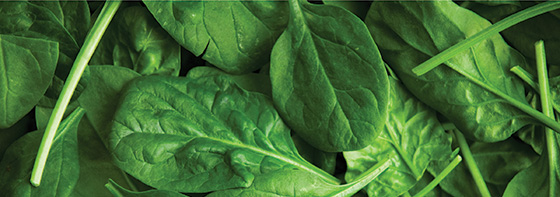Locally grown versus commercially grown spinach; China leads in salt intake
NEWS
Evaluating locally and commercially grown spinach
Consumer demand for locally grown fresh produce is increasing in the United States, with high tunnel systems being successfully used by small acreage growers for local production. Although a common perception exists among consumers that locally grown produce tastes better than nonlocal, there is little evidence to support the claim.
A study in the Journal of Food Science explored consumer acceptability of and the sensory characteristics/differences between locally grown spinach and nonlocal commercially grown spinach. For the study, Spinacia oleracea was grown locally in open field and in high tunnel; the commercially grown spinach was purchased at a retail store. A consumer study (n = 205) and a descriptive sensory analysis by a highly trained descriptive analysis panel were conducted.
The consumer test showed that high tunnel spinach scored significantly higher in overall liking (P < 0.0001), flavor liking (P < 0.0001), and texture liking (P < 0.05) when compared with open field and store-purchased spinach. Descriptive analysis showed that locally grown spinach had a higher intensity of attributes indicating premium organoleptic quality, such as green color and green/spinach flavors. The results, concluded the researchers, can be used for developing marketing strategies aimed at consumers seeking fresh produce of high organoleptic quality.
‘Buy-me’ black
Researchers from Brigham Young University and the Netherlands’ Delft University of Technology may have figured out the secret to get people to buy more fresh produce: dress veggies up in black.
The study looked at how grocery store display backgrounds affected the attractiveness of vegetables. After testing an array of colors and neutral shades, the researchers found that cool, warm, orange, and blue-hued backgrounds were not optimal for presentation. The one color that brought out the shine in most vegetables was black.
“If the goal is to boost sales of fresh produce in retail stores, it makes sense that vendors present them in an attractive and appetizing manner,” said study co-author Bryan Howell. “In the design world, black has always been the cool color, but I didn’t know it would carry over into the vegetable world.”
When rating attractiveness and perceived expensiveness of five vegetables—mushroom, bell pepper, carrot, tomato, and eggplant—the study participants rated yellow peppers the most attractive and expensive across all backgrounds, while carrots generally rated the least attractive and expensive. However, carrots got the biggest boost in ratings when paired with a black background, even surpassing eggplants and mushrooms in attractiveness.
“I think stores can do a much better job at presenting their vegetables than they do,” Howell said. “This is a bit of fun research that can help.”
China leads world in salt intake
Salt intake in China is among the highest in the world, with adults consuming on average above 10 g of salt a day, more than twice the recommended limit, according to new research led by Queen Mary University of London.
The researchers reviewed all data ever published on salt intake in China and found consistently high intake over the past four decades, with a North-South divide. The systematic review and meta-analysis also found that Chinese children aged 3–6 are eating the maximum amount of salt recommended by the World Health Organization for adults (5 g/day) while older children eat almost 9 g/day.
When reviewing potassium intake, which has the opposite effect of sodium on blood pressure, the researchers found that it has been consistently low, with individuals of all age groups consuming less than half the recommended minimum intakes.
“Urgent action is needed in China to speed up salt reduction and increase potassium intake,” said lead author Monique Tan. “High blood pressure in childhood tracks into adulthood, leading to cardiovascular disease. If you eat more salt whilst you are young, you are more likely to eat more salt as an adult, and to have higher blood pressure. These incredibly high salt, and low potassium, figures are deeply concerning for the future health of the Chinese population.”
British food deemed healthiest
A global survey has found that when it comes to having the healthiest packaged foods and drinks, the United Kingdom tops the charts, with the United States in second place and Australia coming in third.
The George Institute for Global Health analyzed more than 400,000 food and drink products from 12 countries and territories around the world. The countries were ranked using Australia’s Health Star Rating system, which measures energy, salt, sugar, saturated fat, as well as protein, calcium, and fiber and assigns a star rating from 0.5 (least healthy) to 5 (the most healthy).
It found that the United Kingdom had the highest average Health Star Rating of 2.83, followed by the United States at 2.82 and Australia at 2.81. India got the lowest rating of just 2.27 followed by China at 2.43 with Chile coming in third from bottom at 2.44.
“Globally we’re all eating more and more processed foods and that’s a concern because our supermarkets’ shelves are full of products that are high in bad fats, sugar, and salt and are potentially making us sick,” said lead author Elizabeth Dunford. “Our results show that some countries are doing a much better job than others. Unfortunately, it’s the poorer nations that are least able to address the adverse health consequences that have the unhealthiest foods.”
Global tea market to register 5.7% CAGR
The global tea market is anticipated to reach $20 billion by 2025, according to Transparency Market Research, which predicts a compound annual growth rate (CAGR) of 5.7% during the 2017–2025 forecast period. A major factor fueling growth is consumers’ rising awareness of the health benefits of black and green tea.
The fact that tea is one of the most affordable beverages has increased its popularity among consumers of different economic and social backgrounds. Market players are tapping into the potential of the tea market by targeting different groups of consumers based on their needs.
Asia Pacific is a promising region for premium tea products due to the rising popularity of tea among urban youth and the easy availability of the products. India and China are leading contributors to growth as well as leading exporters across the world. In Europe, tea has gained immense popularity due to the availability of customized products and niche flavors. As a result, key players are focusing on premiumization of products and development of new flavors.
Another factor influencing growth is the rise in tea lounges, which offer hand-picked teas and a space to relax and indulge in conversation. Additionally, the iced tea trend is catching up among consumers across the globe and is expected to make a significant contribution to market expansion.






